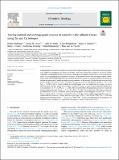Tracing natural and anthropogenic sources of aerosols to the Atlantic Ocean using Zn and Cu isotopes
Abstract
Anthropogenic activities have significantly enhanced atmospheric metal inputs to the ocean, which has potentially important consequences for marine ecosystems. This study assesses the potential of Zn and Cu isotope compositions to distinguish between natural and anthropogenic atmospheric inputs of these metals to the surface ocean. To this end, the isotopic compositions of Zn and Cu in aerosols collected from the eastern tropical Atlantic Ocean on the GEOTRACES GA06 cruise are examined. Enrichment factors and fractional solubility measurements indicate the presence of a significant anthropogenic component in the aerosols collected furthest from the North African dust plume for both Zn and Cu. The mean δ65CuNIST SRM 976 for the fully digested aerosols is +0.07 ± 0.39 ‰ (n = 9, 2 SD), which is indistinguishable from the lithogenic value, and implies that Cu isotopes are not an effective tracer of aerosol sources in this region. The mean δ66ZnJMC-Lyon value for the aerosols that underwent a total digestion is +0.17 ± 0.22 ‰ (n = 11, 2 SD). The aerosols leached with ammonium acetate have similar Zn isotope compositions, with a mean of +0.15 ± 0.16 ‰ (n = 7, 2 SD). The aerosols were collected in a region with prevalent mineral dust but, despite this, exhibit isotopically lighter Zn than lithogenic Zn with δ66Zn ≈ +0.3 ‰. When coupled with the previously published Pb isotope data, the aerosols exhibit coupled Zn-Pb isotope systematics that are indicative of mixing between mineral dust (δ66Zn = +0.28 ‰ and 206Pb/207Pb = 1.205) and anthropogenic emissions (δ66Zn = −0.22 ‰ and 206Pb/207Pb = 1.129). This demonstrates the potential of Zn isotopes to trace atmospheric Zn inputs from anthropogenic sources to the surface ocean.
Citation
Packman , H , Little , S H , Baker , A R , Bridgestock , L , Chance , R J , Coles , B J , Kreissig , K , Rehkämper , M & van de Flierdt , T 2022 , ' Tracing natural and anthropogenic sources of aerosols to the Atlantic Ocean using Zn and Cu isotopes ' , Chemical Geology , vol. 610 , 121091 . https://doi.org/10.1016/j.chemgeo.2022.121091
Publication
Chemical Geology
Status
Peer reviewed
ISSN
0009-2541Type
Journal article
Description
Funding: SL, AB and HP report financial support was provided by Natural Environment Research Council.Collections
Items in the St Andrews Research Repository are protected by copyright, with all rights reserved, unless otherwise indicated.

